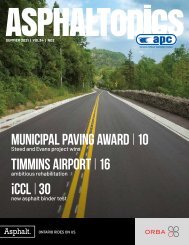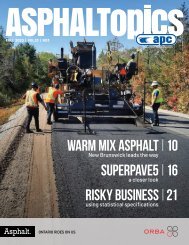ASPHALTopics | Spring 2014 | VOL 27 | NO 1
You also want an ePaper? Increase the reach of your titles
YUMPU automatically turns print PDFs into web optimized ePapers that Google loves.
TECHNICALLY<br />
SPEAKING<br />
by Sandy Brown<br />
OHMPA Technical Director<br />
Potholes – fact and fiction<br />
Thanks to the polar vortex, pothole season arrived a little<br />
early this year. As a result, this winter there has been a lot<br />
of talk in the media about potholes and whether there<br />
could be a cure for what ails the roadways.<br />
The reality is that there is no panacea for potholes.<br />
Potholes typically occur five to seven years after the<br />
road is paved and are the result of water that gets into<br />
the pavement. When the ground freezes, so does the water,<br />
causing expansion. Repeated freezing and thawing of the<br />
water in the pavement structure weakens the surfacing to<br />
the point where the weight of passing vehicles begins<br />
to break up the pavement matrix and a pothole is born.<br />
The key to pothole prevention is to build a durable<br />
road with good drainage, adequate pavement thickness,<br />
and tight longitudinal joints. You also need to properly<br />
maintain the road by sealing the cracks and the longitudinal<br />
joints. If water doesn’t get to the pavement in the<br />
first place, the pothole problem is resolved.<br />
There has also been a lot of talk about the quality of the<br />
asphalt cement in Ontario with references in the media to<br />
“garbage asphalt”. Nothing could be further from the truth.<br />
All asphalt cement used by Ontario municipalities meets<br />
OPSS.MUNI 1101 specifications and this specification is<br />
under constant development. MTO and industry formed<br />
a Binder Task Group in 2006 to look at improving the<br />
performance of asphalt cement used in Ontario. Initially<br />
the group looked at low temperature performance, but<br />
the scope has broadened to include other aspects.<br />
The municipal specification is revised regularly and the<br />
latest revision, issued in November of 2013, is based on<br />
work by the Task Group. The specification incorporates<br />
two new test procedures. The first limits the use of<br />
polyphosphoric acid (PPA) and the second limits the use<br />
Re-refined Heavy Vacuum Distillate Oil (RHVDO) residue.<br />
However, there is no municipal specification in Ontario<br />
for the use of polymers, and in particular elastomeric<br />
polymers, in asphalt cement. Polymer modification<br />
was introduced in North America in the 1970s, but it<br />
wasn’t until we started to specify asphalt cement using<br />
Superpave Performance Grading (PGAC) in the late<br />
1990s that polymer use became more prevalent. PGAC<br />
grading requires the asphalt cement to perform over<br />
a wider range of temperature reflecting different traffic<br />
and environmental conditions.<br />
There is no “new asphalt” as has been referenced in the<br />
media. Higher performance asphalt cements have been<br />
available in Ontario for municipal use since the adoption<br />
of the Superpave specification, but they are seldom asked<br />
for because there is an increase in cost. These materials<br />
are available and specified in OPSS.MUNI 1101 under<br />
what is called grade bumping. While typically only used<br />
on higher traffic roads, products such as PGAC 70-28 have<br />
been available for over 10 years and can be specified on<br />
any project.<br />
The MTO and Industry Binder Task Group have been<br />
studying new test procedures for asphalt cement for the<br />
last seven years. Two different test procedures have been<br />
reviewed: The Double Edge Notched Tension (DENT)<br />
test (using equipment originally introduced in 1910), and<br />
a newer procedure developed in the United States called ››<br />
CONTINUES ON PAGE 36<br />
SPRING <strong>2014</strong> 31


















